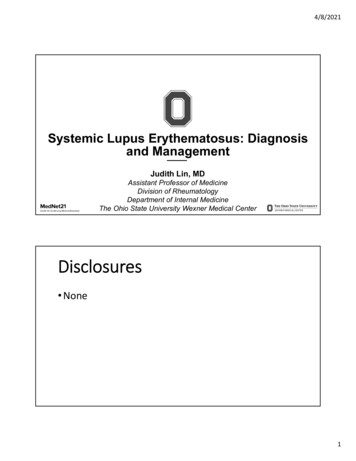
Transcription
Information for Behavioral Health Providers in Primary CareLupus Information SheetWhat is Lupus?Lupus is a chronic, autoimmune disease that can damage any part of the body (skin,joints, and/or organs inside the body). Chronic means that the signs and symptomstend to last longer than six weeks and often for many years. In lupus, somethinggoes wrong with the immune system, which is the part of the body that fights offviruses, bacteria, and germs ("foreign invaders," like the flu). Normally our immunesystem produces proteins called antibodies that protect the body from theseinvaders. Autoimmune means the immune system cannot tell the difference betweenthese foreign invaders and the body’s healthy tissues ("auto" means "self") andcreates autoantibodies that attack and destroy healthy tissue. These autoantibodiescause inflammation, pain, and damage in various parts of the body. Lupus is also a disease of flares (the symptoms worsen and the patient feelsill) and remissions (the symptoms improve and the patient feels better). Lupuscan range from mild to life-threatening and should always be treated by adoctor. With good medical care, most people with lupus can lead a full life. Lupus is not contagious, not even through sexual contact. You cannot "catch"lupus from someone or "give" lupus to someone. Lupus is not like or related to cancer. Cancer is a condition of malignant,abnormal tissues that grow rapidly and spread into surrounding tissues.Lupus is an autoimmune disease, as described above. Lupus is not like or related to HIV (Human Immune Deficiency Virus) or AIDS(Acquired Immune Deficiency Syndrome). In HIV or AIDS the immune system isunderactive; in lupus, the immune system is overactive. It is estimated that at least 1.5 million Americans have lupus. The actualnumber may be higher; however, there have been no large-scale studies toshow the actual number of people in the U.S. living with lupus. It is believed that 5 million people throughout the world have a form of lupus.
Lupus Information Sheet (continued) Lupus strikes mostly women of childbearing age (15-44). However, men,children, and teenagers develop lupus, too. Women of color are 2-3 times more likely to develop lupus. People of all races and ethnic groups can develop lupus. More than 16,000 new cases of lupus are reported annually across thecountry.What causes Lupus?GenesNo gene or group of genes has been proven to cause lupus. Lupus does, however,appear in certain families, and when one of two identical twins has lupus, there isan increased chance that the other twin will also develop the disease. Thesefindings, as well as others, strongly suggest that genes are involved in thedevelopment of lupus. Although lupus can develop in people with no family historyof lupus, there are likely to be other autoimmune diseases in some family members.Certain ethnic groups (people of African, Asian, Hispanic/Latino, Native American,Native Hawaiian, or Pacific Island descent) have a greater risk of developing lupus,which may be related to genes they have in common.EnvironmentWhile a person’s genes may increase the chance that he or she will develop lupus, ittakes some kind of environmental trigger to set off the illness or to bring on a flare.Examples include: ultraviolet rays from the sun ultraviolet rays from fluorescent light bulbs sulfa drugs, which make a person more sensitive to the sun, such as: Bactrim and Septra (trimethoprim-sulfamethoxazole); sulfisoxazole (Gantrisin );tolbutamide (Orinase ); sulfasalazine (Azulfidine ); diuretics sun-sensitizing tetracycline drugs such as minocycline (Minocin ) penicillin or other antibiotic drugs such as: amoxicillin (Amoxil ); ampicillin(Ampicillin Sodium ADD-Vantage ); cloxacillin (Cloxapen ) an infection a cold or a viral illness exhaustion an injuryLupus Information Sheet Ver3.0 – July 2013Page - 2
Lupus Information Sheet (continued) emotional stress, such as a divorce, illness, death in the family, or other lifecomplications anything that causes stress to the body, such as surgery, physical harm,pregnancy, or giving birthAlthough many seemingly unrelated factors can trigger the onset of lupus in asusceptible person, scientists have noted some common features among manypeople who have lupus, including: exposure to the sunan infectionbeing pregnantgiving birtha drug taken to treat an illnessHowever, many people cannot remember or identify any specific factor thatoccurred before they were diagnosed with lupus.HormonesHormones are the body’s messengers and they regulate many of the body’sfunctions. In particular, the sex hormone estrogen plays a role in lupus. Men andwomen both produce estrogen, but estrogen production is much greater in females.Many women have more lupus symptoms before menstrual periods and/or duringpregnancy, when estrogen production is high. This may indicate that estrogensomehow regulates the severity of lupus. However, it does not mean that estrogen,or any other hormone for that matter, causes lupus.Types of Lupus?Systemic Lupus Erythematosus. Systemic lupus is the most common form of lupus,and is what most people mean when they refer to "lupus." Systemic lupus can bemild or severe. Some of the more serious complications involving major organsystems are: inflammation of the kidneys (lupus nephritis), which can affect the body’sability to filter waste from the blood and can be so damaging that dialysisor kidney transplant may be needed an increase in blood pressure in the lungs (pulmonary hypertension)Lupus Information Sheet Ver3.0 – July 2013Page - 3
Lupus Information Sheet (continued) inflammation of the nervous system and brain, which can cause memoryproblems, confusion, headaches, and strokes inflammation in the brain’s blood vessels, which can cause high fevers,seizures, behavioral changes, hardening of the arteries (coronary artery disease), which is a buildup ofdeposits on coronary artery walls that can lead to a heart attackCutaneous Lupus Erythematosus. Cutaneous refers to the skin, and this form oflupus is limited to the skin. Although there are many types of rashes and lesions(sores) caused by cutaneous lupus, the most common rash is raised, scaly and red,but not itchy. It is commonly known as a discoid rash, because the areas of rash areshaped like disks, or circles. Another common example of cutaneous lupus is a rashover the cheeks and across the bridge of the nose, known as the butterfly rash.Other rashes or sores may appear on the face, neck, or scalp (areas of the skin thatare exposed to sunlight or fluorescent light), or in the mouth, nose, or vagina. Hairloss and changes in the pigment, or color, of the skin are also symptoms ofcutaneous lupus.Approximately 10 percent of people who have cutaneous lupus will developsystemic lupus. However, it is likely that these people already had systemic lupus,with the skin rash as their main symptom.Drug-induced Lupus Erythematosus. Drug-induced lupus is a lupus-like diseasecaused by certain prescription drugs. The symptoms of drug-induced lupus aresimilar to those of systemic lupus, but only rarely will any major organs be affected.The drugs most commonly connected with drug-induced lupus are hydralazine (usedto treat high blood pressure or hypertension), procainamide (used to treat irregularheart rhythms), and isoniazid (used to treat tuberculosis). Drug-induced lupus is morecommon in men because they are given these drugs more often; however, noteveryone who takes these drugs will develop drug-induced lupus. The lupus-likesymptoms usually disappear within six months after these medications are stopped.Neonatal Lupus. Neonatal lupus is a rare condition that affects infants of womenwho have lupus and is caused by antibodies from the mother acting upon the infantin the womb. At birth, the infant may have a skin rash, liver problems, or low bloodcell counts, but these symptoms disappear completely after several months with nolasting effects. Some infants with neonatal lupus can also have a serious heartdefect. With proper testing, physicians can now identify most at-risk mothers, andthe infant can be treated at or before birth. Most infants of mothers with lupus areentirely healthy.Lupus Information Sheet Ver3.0 – July 2013Page - 4
Lupus Information Sheet (continued)What are the Symptoms of Lupus?Because lupus can affect so many different organs, a wide range of symptoms canoccur. These symptoms may come and go, and different symptoms may appear atdifferent times during the course of the disease. The most common symptoms oflupus, which are the same for females and males, are: extreme fatigue (tiredness)headachespainful or swollen jointsfeveranemia (low numbers of red blood cells or hemoglobin, or low total bloodvolume)swelling (edema) in feet, legs, hands, and/or around eyespain in chest on deep breathing (pleurisy)butterfly-shaped rash across cheeks and nosesun- or light-sensitivity (photosensitivity)hair lossabnormal blood clottingfingers turning white and/or blue when cold (Raynaud’s phenomenon)mouth or nose ulcersMany of these symptoms occur in other illnesses besides lupus. In fact, lupus issometimes called "the great imitator" because its symptoms are often like thesymptoms of rheumatoid arthritis, blood disorders, fibromyalgia, diabetes, thyroidproblems, Lyme disease, and a number of heart, lung, muscle, and bone diseases.Diagnosing LupusUnlike other chronic illnesses, trying to reach a diagnosis of lupus isn’t always easy.However, today’s physicians have more precise techniques and tests to detect signsof disease.How Is Lupus Diagnosed? Because many symptoms of systemic lupuserythematosus (SLE) mimic those of other illnesses, lupus can be a difficult disease todiagnose. The diagnosis of lupus is based off of a combination of physicalsymptoms and laboratory results and for most people is not a onetime diagnosis.More often than not it is a diagnosis that evolves over time either towards morecertainty that a person does or does not meet the criteria for a diagnosis of lupus.Lupus Information Sheet Ver3.0 – July 2013Page - 5
Lupus Information Sheet (continued)So what is the physician looking for to help determine if the patient may havelupus?Common Symptoms of Lupus.above.The symptoms of lupus have been describedLaboratory Tests for Lupus. Lupus is characterized by abnormalities in manylaboratory test results. These abnormalities are different for every patient and theyvary significantly during the course of a patient’s disease. The serial evaluation ofan individual’s tests along with the physician’s observations and the patient’s historydetermine the diagnosis of systemic lupus erythematosus (SLE), its course, and thetreatment regimen. All laboratory values must be interpreted in light of the patient’spresent status, other correlating laboratory test results, and coexisting illnesses. Thischapter briefly describes the major tests used to diagnose and evaluate SLE andprovides information on their rationale and clinical usefulness.What Do These Test Results Mean? Understanding these tests and what the testresults mean can be difficult. In many cases, it can take months or even years fordoctors to put together all of the information that is required to make a firmdiagnosis of lupus. It is important to have thorough and ongoing communication witha physician so that the proper diagnosis, whether of lupus or some other condition,can be made as early and accurately as possible.Treating LupusFor most people with lupus, proper treatment can minimize symptoms, reduceinflammation and pain, and stop the development of serious organ damage. Theinformation found here will help you understand the most commonly prescribedmedicines today, and other drugs under investigation for treating lupus.Treatments for Lupus. Health professionals continue to search for better ways tocare for and treat people with lupus. Understanding what causes the disease andwhy certain people are more likely to develop it may one day lead to promisingnew treatments for, or even prevention of, lupus. In the meantime, researcherscontinue to look for new treatments and ways to modify existing ones so they candiminish or eliminate side effects and improve the quality of life for people whohave lupus.Medications to Treat Lupus Symptoms. Medications are important for managingmany systemic lupus erythematosus (SLE) patients. An array of drug therapies is nowavailable, and this has increased the potential for effective treatment and costeroids,Antimalarials,Lupus Information Sheet Ver3.0 – July 2013Page - 6
Lupus Information Sheet (continued)Immunosuppressives medication and Anticoagulants may be used in the treatment oflupus symptoms.Investigational Treatments for Lupus. People with serious illnesses who are notresponding to already available treatments sometimes enroll in clinical trials to gainaccess to medical treatments that could be helpful. Here you will find information onBiologics, Hormones, Immunosuppressives (Immune Modulators), MonoclonalAntibodies, Organ Transplant Anti-Rejection Drugs, Stem Cell Transplantation andTropical Immunomodulators (TIMs) therapies.The Best Approach to Taking Medications. Knowing your medications and beingcareful to take them as prescribed can sometimes be a daunting task especially ifthe side effects seem to be worse than the lupus disease itself. This section willdiscuss how you and your health care team can work to develop the best treatmentplan for you. Open communication and knowledge is the best approach tomanaging your lupus.Complementary and Alternative Medicines and Therapies. This section looks atthe role of complementary and alternative medications as a balanced approach tothe management of lupus. Before you add herbs, dietary supplements, or vitaminsto your diet, discuss this with your doctor, as these products may interact with drugsused to treat lupus. Dietary supplements should never be used to replace medicinesprescribed to control lupus symptoms or medication side effects.Center for Clinical Trials Education (CCTE). There has not been a drug approvedspecifically for the treatment of lupus in more than 40 years. There are a variety ofreasons for this. Some are due to the complexities of the disease itself, as well ashow clinical trials are designed and completed. This section will provide you withinformation on how Clinical Trials are increasing the understanding of lupus and thedevelopment of new treatments.LFA Approved Publications. The Lupus Foundation of America Patient EducationCommittee has reviewed and approved a number of publications and othermaterials for use in educating individuals and families about lupus and its healtheffects.Final Notes of Caution. All medicines must be taken exactly as prescribed!Forgetting to take the medicine, taking medicine in the wrong amounts or dosage,stopping a medicine, or adding dietary supplements without your doctor’s approvalwill affect how well the drugs work and whether your symptoms of lupus can bebrought under control.Lupus Information Sheet Ver3.0 – July 2013Page - 7
Lupus Information Sheet (continued)Managing lupus is a team effort. And since there often will be several physiciansinvolved in the care of a patient, good communication is necessary among membersof your health care team.Adapted from: http://www.lupus.org/ ,the website of the Lupus Foundation ofAmericanThese Information Sheets are designed to provide a brief overview of various medical conditions.Referring to the Information Sheets may help you communicate more effectively with othermembers of the Primary Care Team. The Information Sheets are by no means an exhaustivedescription of the disorders. If you need additional information, please engage in a moredetailed search. Don’t forget to consult with other members of the Primary Care Team. They arean invaluable source of information!Lupus Information Sheet Ver3.0 – July 2013Page - 8
Approximately 10 percent of people who have cutaneous lupus will develop systemic lupus. However, it is likely that these people already had systemic lupus, with the skin rash as their main symptom. Drug-induced Lupus Erythematosus. Drug-induced lupus is a lupus-like disease caused by certain prescription drugs. The symptoms of drug-induced .










